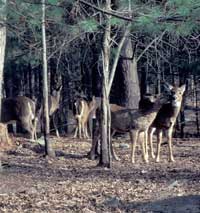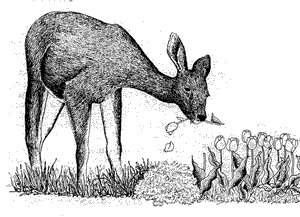What Deer Look Like
 |
Whitetail deer range over much of the eastern part of the US. Particularly dense populations have developed in Pennsylvania, Long Island and areas north of New York City into New England. Deer are usually first visible in the spring. Often a family arrives, perhaps a doe with half-grown fawns from the previous season. Bucks may be in the area, but they do not appear in the open as often.
Deer families usually feed in the late evening or early morning when no one is around. As summer gets underway, they may retire for awhile to the forest where the doe gives birth to new fawns. She cares for her children over the summer, emerging with them to feed openly again in the fall to store up for winter. One or two deer can virtually destroy an ornamental or vegetable planting in one night.
Deer’s Feeding Habits
 |
A mature whitetail deer devours between 5 and 7 pounds of food a day. Browsers, they eat grass, moss, mushrooms, berries, pine cones, evergreens and even roses and brambles in an emergency in the wild. They eat what is available over the seasons. For instance, in the winter they focus on available evergreen conifers. In the spring when food sources are scarce, yet pregnant females need good nutrition, they go after tender new growth on trees and leaking sap from broken branches, even if they have to get up on their hind legs to reach them.
If natural areas have been replaced with cultivated yards deer will make do with whatever is available there. Deer that are not under pressure of starvation show definite food preferences. While it is difficult to predict the favorites of deer in a particular locality, most tend to avoid strong flavored foliage, or plants with prickly or fuzzy foliage. If they are starving, all bets are off.

